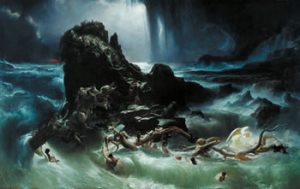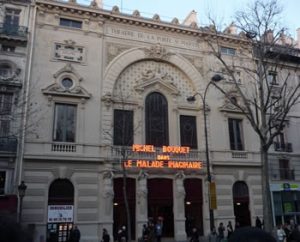Curiosities for the American Museum
Advertisements for Barnum’s American Museum always trumpet the many thousands of “curiosities” that visitors could see once they had paid to enter, like a new world laid before them. Were these curiosities the “humbugs” (often mistakenly called hoaxes) that so many people associate with P. T. Barnum? The answer is no, not many. In Barnum’s day “curiosities” had a broader meaning, encompassing virtually anything that was unfamiliar or unusual. While today the word is more likely to conjure images of very strange or supremely unusual objects, either peculiar by nature or oddities and relics of human creation, for Barnum, the countless items in the museum’s natural history collection, antiquities and historical objects were all bona fide “curiosities.”
But Barnum wanted to do more than just display curiosities; his goal was to entice ordinary people to want to learn about the world, to be curious, to question, and to enjoy discovering new things. So to spice things up, humbugs and fakes found their way in among the displays of “serious” specimens, artifacts, and art. These were intended to provoke conversation and perhaps spark debate or moments of amusement for visitors—in other words, pique people’s curiosity through a visceral response that challenged them to think. Barnum knew that his success depended upon making his visitors’ experiences at the museum memorable. (Just the same as today!)
A couple of my previous blogs drawing from Barnum’s letter copybook have highlighted his acquisitions of impressive and “showy” items while he was in France, things like automatons, huge panoramas, and unusual live animals. This week we will explore purchases of curiosities for the museum. While on the European tour in the mid-1840s, Barnum did not neglect the chance to add new specimens to the Museum’s natural history collection, and expand the ancient relics and archaeological collections with more artifacts. He also sought to have copies made of historical paintings. Since Barnum was the “advance man” for General Tom Thumb’s tour, he was in a position to scout opportunities and then send instructions to his employees in the General’s entourage. Citing the leisure time he expected they’d have after taking care of the tour responsibilities, he suggested places they should visit to seek items to purchase, but advised buying only if the items were “striking” and the prices reasonable.
The “players” in this story are Mr. Sherman, an antiquarian and young Charles Stratton’s precepteur (tutor); Sherwood Stratton, who was Charles’s father and according to Barnum, a person with no intellectual curiosity whatsoever; and Monsieur Pinte, a well-educated Frenchman hired as the interpreter for the Strattons and others, and who apparently was considering creating his own “show” or “museum” despite his distaste for being called a showman—a point Barnum often teased him about. We will also discover a bit more about Monsieur Emile Guillaudeu, the American Museum’s naturalist and taxidermist, who was the subject of my August 28, 2020, blog.
Writing to Mr. Sherman on October 16th from Lyon, Barnum directed him thus:
I have been thinking that at those shops on the quay [in Marseille] where they have so many birds and shells for sale, that undoubtedly you can pick up plenty of bird skins, ready for old Guilledeaus use to stuff. Please inquire and if you can get from 30 to 100 skins of different African birds (say 3 pairs of each kind) which are pretty or odd and which we have probably not already got in the museum you may get them provided they do not cost too much. They should not average over 3 francs each skin, and probably may be got for half the money. The living birds are sold in Marseilles for 3 francs each when a person buys 20 or 30.
He went on to caution, “Dont buy for the sake of buying—merely buy if they are pretty and new—I mean new in New York—and even then dont pay too much.” Mr. Stratton was to provide Sherman with the funds for the purchases, which Barnum would later reimburse.
Since Sherman’s expertise was not in biological specimens, Barnum suggested that he “soft soap the naturalist at the museum” so as to get a couple of hours of his time assessing the bird skins, noting “[the naturalist’s] judgment is worth much more than both of ours on this subject.” However, he added that Sherman should “Look out that he dont shave you.” Barnum also advised taking interpreter Pinte with him not only to ensure he understood the naturalist but also because “The lesson will help Pinte towards starting his show in France.”
From a present day museum professional’s perspective, Barnum’s next advisory, in a postscript to his October 20th letter to Sherman, is rather jarring: “I wish you & Mr. Showman Pinte would stroll into the museum & have a talk with the manager—and if you can buy some Roman Antiquities cheap get me some which are good & striking—say from 40 to 200 francs worth, but don’t buy unless you think it is an object.” Clearly there was no museum code of ethics! Barnum also recommended stopping into some old curiosity shops along the quay in Marseille where might be purchased “Roman remains, or old sabres or arms.”
In a more collegial vein regarding the museum visit, Barnum recommended that Sherman “also talk to the manager about exchanging curiosities for something which can be found in America. Learn what he wants from America—whether he wants the skin of a moose—a Buffalo—and what other American animals or birds.” In addition, Barnum saw an opportunity to get the museum director to facilitate a purchase in case Sherman was unable to persuade or negotiate with the seller himself. He counseled,
Among the birds of paradise in the museum I saw a couple of that species, which appeared like rich velvet, they are entirely new to me. The porter of the museum said there was a person in town who had one to sell. If you can get the director to procure it you may go as high as 75 francs for it or even 100 francs if you cant do better. I hope however you can get it for 25 to 30 & guess you can for less than 50.
If any or all of these transactions were successful, I suspect Mon. Guillaudeu had plenty of work ahead of him to mount the skins, as well as possibly having to get an American moose or buffalo hide for the French museum. The October 20th letter also provides some interesting tidbits about Guillaudeu’s family, as Barnum was supposed to meet his employee’s nephew in Lyon. Barnum wrote Sherman, “Guillaudeu’s nephew is out of town, as it is vacation. He is a student of the school of painting, which is also in the museum.”
Barnum thus missed meeting him, but anticipating that Sherman’s arrival in Lyon would coincide with the nephew’s return to art school, he added,
He will be in town and call on you. Give him my compliments & tell him I am sorry I could not have seen him. He will hand you a couple of family pictures for Mr Guilledeau. His name is Hyacinth Chevalier.

Here again, Barnum saw an opportunity: Why not ask the young art student to make copies of paintings displayed at the museum, which could then be shipped back to the American Museum? (Copying masterpieces was a traditional method by which artists learned to paint.) Barnum thereby instructed Sherman,
Look at the three following paintings in the museum and ask him [Chevalier] or the manager or both, what I must pay for a good copy of each.
1 – The Deluge
2 – Cain flying running after murdering Abel.
3 – Cain in the desert ^ or somewhere else with his family after killing Abel.
They are all striking pictures & if Chevalier wont charge much to copy them I’ll have them. Ask the price.
It is possible that the first painting Barnum listed was the work of Irish artist Francis Danby (1793 – 1861), who painted an intensely dramatic scene of the Biblical flood. It was first exhibited in 1840. There are, of course, other paintings also titled The Deluge, but this one being relatively new in 1845 and being the sensational and stirring sort of depiction that Barnum would have wanted for his museum leads me to think he was referring to Danby’s painting. (The Deluge is now in the collection of the Tate Gallery in London.)

I don’t have an answer at this point as to whether Chevalier took Barnum up on the offer to pay for copies of the paintings. But, un petit encadré (a little sidebar) here: I did learn from other sources that Chevalier went on to become a professional artist—a sculptor, not a painter—and that he lived and worked in Paris until his death in 1893. He is best known for his work on the Théâtre de la Porte Saint-Martin in Paris. After the original 18th century theater and opera house was destroyed by fire during the Paris commune of 1871, the architect in charge of its replacement hired Chevalier to do the elaborate façade and design the interior. Take a good look at the photo and you’ll see four full-length figures at the entrance, and a myriad of faces throughout the façade, including a row along the roofline. When I noticed these details, it struck me that Hyacinthe Chevalier—and his uncle Emile Guillaudeu—would really have enjoyed seeing our Barnum Museum building, with its intricately sculpted façade and frieze, and among the abundant details, so many faces and animals!
Adrienne Saint-Pierre
Barnum Museum Curator

